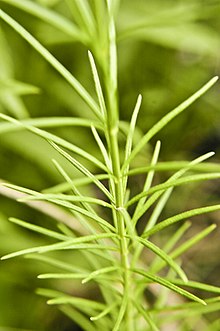Asclepias verticillata
| Asclepias verticillata | ||||||||||||
|---|---|---|---|---|---|---|---|---|---|---|---|---|

Asclepias verticillata |
||||||||||||
| Systematics | ||||||||||||
|
||||||||||||
| Scientific name | ||||||||||||
| Asclepias verticillata | ||||||||||||
| L. |
Asclepias verticillata , sometimes also called whorleaved milkweed , is a species of silk plants ( Asclepias ) in the subfamily of silk plants (Asclepiadoideae). It iswidespreadin North America .
description
Vegetative characteristics
Asclepias verticillata grows as a perennial, herbaceous plant and reaches heights of 15 to 90 cm. It forms short, superficial "root stocks". The upright, slender, somewhat angular stems are unbranched, rarely branched with sterile stems. They are more or less white, downy hairy, which descends in lines from the nodes, rarely also bald.
The leaves are seldom opposite, usually three to six leaves are arranged in whorls on the stem, hence the specific epithet verticillata . They are at most very short stalked and upright to spread out or slightly bent back. The membranous, mostly bald to tiny downy hairy, and simple leaf blade is linear with a length of 1.5 to 7 cm and a width of about 1.5 mm, or usually narrowly elongated to thread-like with a smooth, bent leaf edge and a pointed end.
Generative characteristics
Individually or in pairs to the upper node ( Nodien standing), doldigen inflorescences contained six to twenty flowers. The slender inflorescence stem has a length of 1.5 to 3 cm. The slender flower stalks have a length of about 6 mm.
The relatively small flowers are hermaphroditic, radial symmetry and five-fold. The flower colors range from whitish to greenish white to sometimes with a purple tinge. The five sepals are approximately triangular with a length of about 3.5 mm and sparsely hairy to almost bald. The back curved and bald petals are elliptical with a length of about 3.5 mm. The gynostegium has a short stalk, the stalk is columnar with a diameter of about one millimeter. The staminal corolla lobes are hood-shaped, sub-square and about 1.5 mm long. The interstaminal corona lobes sit basally and are curved needle-shaped. They are about twice as long as the staminal corolla lobes and curve gradually over the stylus head. The stylus head is cylindrical and about 2 mm high; the diameter is slightly smaller. The flowers stay open for 4 to 5 days before they die. Nectar is mainly produced between 6 p.m. and 10 p.m.
The follicles , which stand upright on upright stems, are glabrous or hairy and thinly spindle-shaped with a length of 7 to 10 cm and a diameter of 5 to 8 mm. She. On the outside they are fat and bald. The egg-shaped seeds with a length of about 5 mm have a 2.5 cm long head of white hair.
Occurrence
Asclepias verticillata is found in the Canadian provinces of Manitoba and Ontario as well as in the US states of Alabama, Arkansas, Connecticut, Florida, Georgia, Illinois, Indiana, Iowa, Kansas, Kentucky, Louisiana, Maryland, Massachusetts, Michigan, Minnesota, Mississippi, Nebraska , New Jersey, New York, North Carolina, North Dakota, Ohio, Oklahoma, Pennsylvania, Rhode Island, South Carolina, South Dakota, Tennessee, Texas, Virginia, West Virginia and Wisconsin.
Asclepias verticillata thrives on dry prairies , on rocky hills, in bushland and in sparse forests, mostly in dry soils over limestone and sand dunes . They can also be found along roads and fence edges. It reproduces not only through seeds, but also vegetatively. It cannot fertilize itself, i. H. the specimens of a colony of clones are mutually sterile. The main pollinators are wasps and night butterflies, subordinate to native bees and day butterflies. Among the introduced or introduced insects, honey bees and cabbage whites in particular use the flowers as a source of nectar and also transmit the pollen packets (pollinia). Native wasps are known to feed themselves and their brood almost exclusively on the nectar of the flowers during the flowering period of Asclepias verticillata .
Systematics
The first publication of Asclepias verticillata was made by Carl Linnaeus in Species Plantarum , Volume 1, 1st Edition, Stockholm 1753, p 217. A synonym for Asclepias verticillata L. is Asclepias parviflora Leconte ex Decne. The specific epithet verticillata means whorled, so the leaves are arranged in whorls.
Usage and toxicity
Some North American tribes used Asclepias verticillata in folk medicine to treat snake bites, throat and nose diseases.
Asclepias verticillata is very poisonous for livestock , but since the animals don't like it, it is rarely eaten. It can cause problems when fed as an ingredient in hay.
supporting documents
literature
- Robert E. Woodson, Jr .: The North American Species of Asclepias L. , In: Annals of the Missouri Botanical Garden , Volume 41 (1), St. Louis, Mo., 1954, pp. 1-211: URL (description from Asclepias verticillata on pp. 124–126)
- Mike Haddock, 2007: Kansas Wildflowers and Grasses datasheet . (Section Description, Occurrence, Folk Medicine and Toxicity)
Individual evidence
- ↑ Whorled milkweed ( Asclepias verticillata ).
- ↑ USDA Plants Profile - Asclepias verticillata .
- ^ A b Mary F. Willson, Robert I. Bertin, Peter W. Price: Nectar production and flower visitors of Asclepias verticillata. In: American Midland Naturalist , Volume 102, Part 1, 1979, pp. 23-35 JSTOR: Abstrac .
- ↑ First publication scanned at botanicus.org .
- ↑ Entry at tropicos .

